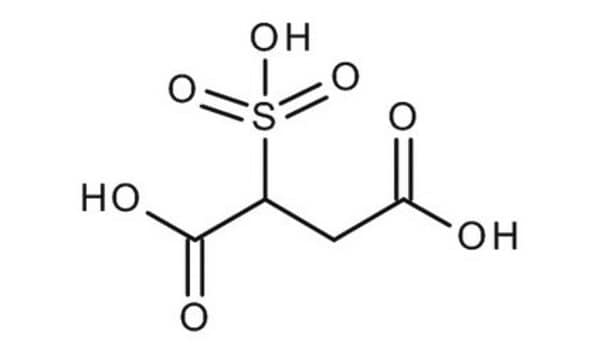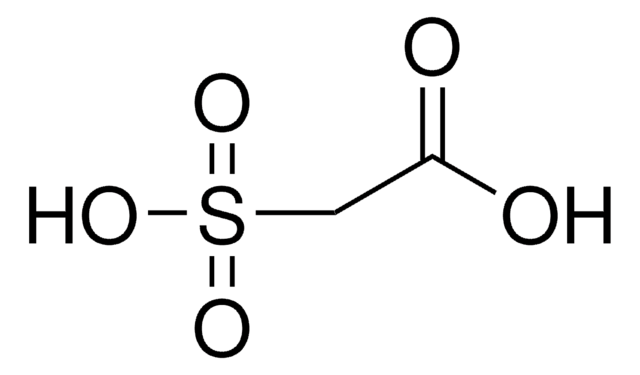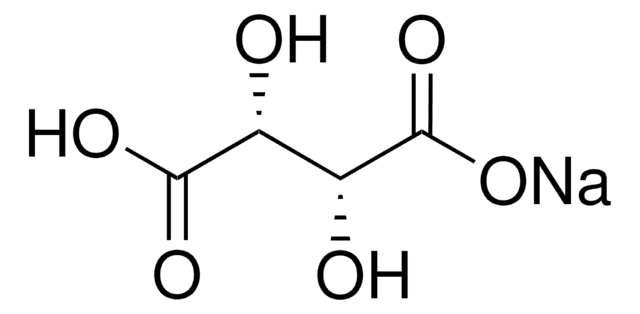338567
Sulfosuccinic acid solution
70 wt. % in H2O
Synonyme(s) :
2-Sulfobutanedioic acid
About This Item
Produits recommandés
Forme
viscous liquid
Niveau de qualité
Concentration
70 wt. % in H2O
Indice de réfraction
n20/D 1.449
Densité
1.438 g/mL at 25 °C
Chaîne SMILES
OC(=O)CC(C(O)=O)S(O)(=O)=O
InChI
1S/C4H6O7S/c5-3(6)1-2(4(7)8)12(9,10)11/h2H,1H2,(H,5,6)(H,7,8)(H,9,10,11)
Clé InChI
ULUAUXLGCMPNKK-UHFFFAOYSA-N
Vous recherchez des produits similaires ? Visite Guide de comparaison des produits
Catégories apparentées
Application
- Modification of nanocellulose membrane by impregnation method with sulfosuccinic acid for direct methanol fuel cell applications: This study examines the use of sulfosuccinic acid in various concentrations to improve the properties of nanocellulose membranes for fuel cells (Sriruangrungkamol & Chonkaew, 2021).
- A high-strength polyvinyl alcohol hydrogel membrane crosslinked by sulfosuccinic acid for strontium removal via filtration: Research focusing on using sulfosuccinic acid to enhance polyvinyl alcohol hydrogel membranes for effective strontium filtration (Yoon et al., 2019).
- Cross-linked poly (vinyl alcohol)/sulfosuccinic acid polymer as an electrolyte/electrode material for H2–O2 proton exchange membrane fuel cells: This paper discusses the application of sulfosuccinic acid in creating cross-linked polyvinyl alcohol for fuel cell membranes (Ebenezer et al., 2016).
- Preparation of chitosan/polyvinyl alcohol blended films containing sulfosuccinic acid as the crosslinking agent using UV curing process: An investigation into using sulfosuccinic acid to crosslink chitosan/polyvinyl alcohol films for improved mechanical properties (Yun et al., 2017).
- Investigation on resistive humidity sensing in sulfosuccinic acid doped polyaniline films: This research explores the potential of sulfosuccinic acid doped polyaniline films for humidity sensing applications (Biswas et al., 2021).
Mention d'avertissement
Danger
Mentions de danger
Conseils de prudence
Classification des risques
Eye Dam. 1 - Skin Corr. 1B
Code de la classe de stockage
8A - Combustible corrosive hazardous materials
Classe de danger pour l'eau (WGK)
WGK 3
Point d'éclair (°F)
Not applicable
Point d'éclair (°C)
Not applicable
Faites votre choix parmi les versions les plus récentes :
Déjà en possession de ce produit ?
Retrouvez la documentation relative aux produits que vous avez récemment achetés dans la Bibliothèque de documents.
Les clients ont également consulté
Notre équipe de scientifiques dispose d'une expérience dans tous les secteurs de la recherche, notamment en sciences de la vie, science des matériaux, synthèse chimique, chromatographie, analyse et dans de nombreux autres domaines..
Contacter notre Service technique











